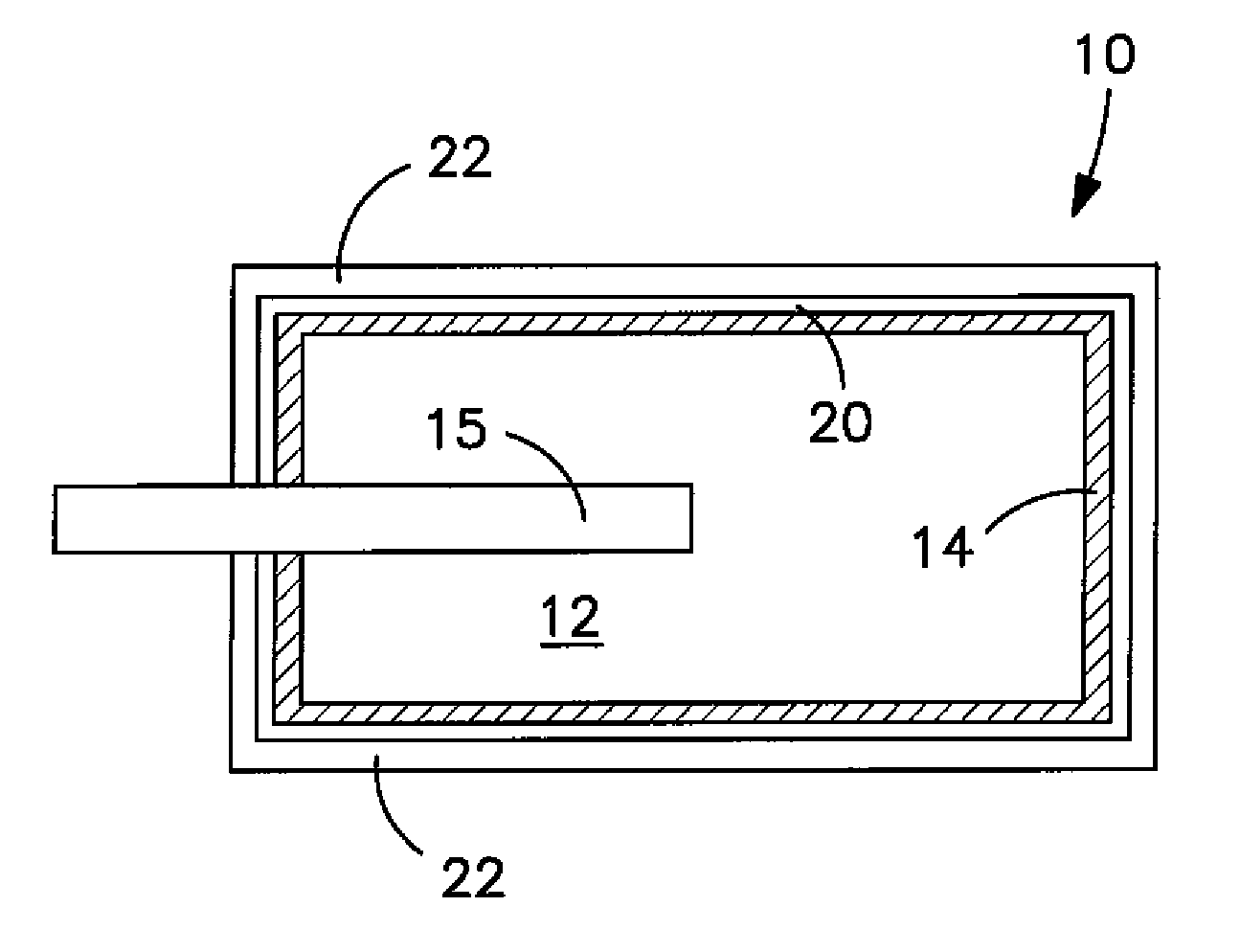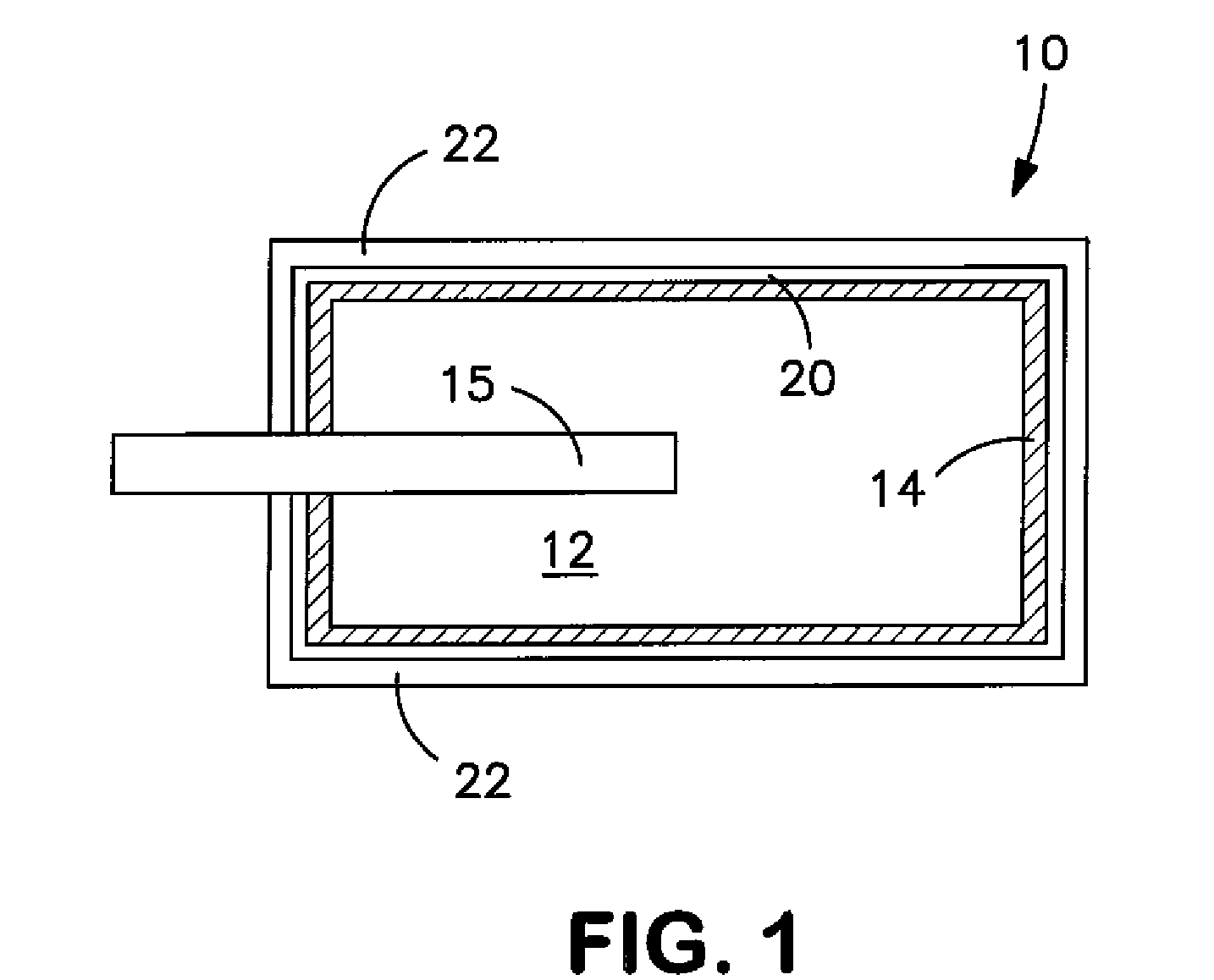Conductive Coating for Use in Electrolytic Capacitors
a technology for electrolytic capacitors and coatings, which is applied in the direction of electrolytic capacitors, liquid electrolytic capacitors, coatings, etc., can solve the problems of adversely affecting electrical performance, increasing the complexity and cost of dispersion, and difficult and costly to achieve a relatively thick solid electroly
- Summary
- Abstract
- Description
- Claims
- Application Information
AI Technical Summary
Problems solved by technology
Method used
Image
Examples
example 1
[0062]The ability to form poly(3,4-ethylenedioxythiophene) / poly(diallyldimethylammonium chloride) (“PEDT / PDDA / Cl”), which has the structure below, was demonstrated:
[0063]The polymer was formed as follows. A solution of 2.79 grams (0.012 mole) of ammonium peroxodisulfate (APS) in 500 milliliters of water was initially placed into a three-necked flask equipped with a stirrer and nitrogen inlet. Under vigorous stirring, a solution that contains 24.1 grams (0.03 mole) of a 20% solution of poly(diallyldimethyl-ammonium chloride) (molecular weight 400,000 grams per mole) in 500 ml water was poured into the flask. A white colored gel was obtained. Then, 1.42 grams (0.01 mol) of 3,4-ethylenedioxythiophene (FOOT) was added to this gel. The temperature was raised to 50° C. and while stirring, the mixture was kept under an inert atmosphere. After 24 hours, a dark-blue aqueous dispersion was obtained. The dispersion was purified from byproducts and unreacted EDOT by filtration and extraction by...
example 2
[0064]The ability to form poly(3,4-ethylenedioxythiophene) / poly(diallyldimethylammonium) / bis(pentafluoroethylsulfonyl)imide (“PEDOT / PDDA / PFSI”), which has the structure below, was demonstrated:
[0065]The polymer was formed as follows. Initially, 16 grams of bis(pentafluoroethylsulfonyl)imide was dissolved in 500 milliliters of water. 1,000 milliliters of the PEDT / PDDA / Cl dispersion of Example 1 was then added over 30 minutes under vigorous stirring. Precipitation of the new polymer occurred and resulted in a blue suspension, which was stirred at room temperature for 2 additional hours and recovered by filtration. The filtration cake was carefully washed by water and dried at room temperature under vacuum to a constant weight. 26 grams of the PEDOT / PDDA / PFSI polymer was obtained, which is readily dispersible in organic solvents, such as dimethylformamide, dimethylsulfoxide, dimethylacetamide or N-methylpyrrolidone.
example 3
[0066]The ability to form poly(3,4-ethylenedioxythiophene) / poly(1-methyl-4-vinylpyridinium) / oleate (“PEDT / PDDA / OA”), which has the structure below, was demonstrated:
[0067]The polymer was formed as follows. Initially, 5.64 grams (0.020 mol) of oleic acid and 0.8 grams (0.020 mol) of sodium hydroxide were dissolved in 150 milliliters of water. 500 milliliters of the PEDT / PDDA / Cl dispersion of Example 1 was gradually added under vigorous stirring. Precipitation of the blue polymer occurred and the resulting suspension was stirred for an additional 60 minutes and then filtered and dried. 8.6 grams of the PEDT / PDDA / OA polymer, which is readily dispersible in methanol, ethanol, acetone, 2-butanone or other organic solvents.
PUM
| Property | Measurement | Unit |
|---|---|---|
| size | aaaaa | aaaaa |
| wt. % | aaaaa | aaaaa |
| melting point | aaaaa | aaaaa |
Abstract
Description
Claims
Application Information
 Login to View More
Login to View More - R&D
- Intellectual Property
- Life Sciences
- Materials
- Tech Scout
- Unparalleled Data Quality
- Higher Quality Content
- 60% Fewer Hallucinations
Browse by: Latest US Patents, China's latest patents, Technical Efficacy Thesaurus, Application Domain, Technology Topic, Popular Technical Reports.
© 2025 PatSnap. All rights reserved.Legal|Privacy policy|Modern Slavery Act Transparency Statement|Sitemap|About US| Contact US: help@patsnap.com



